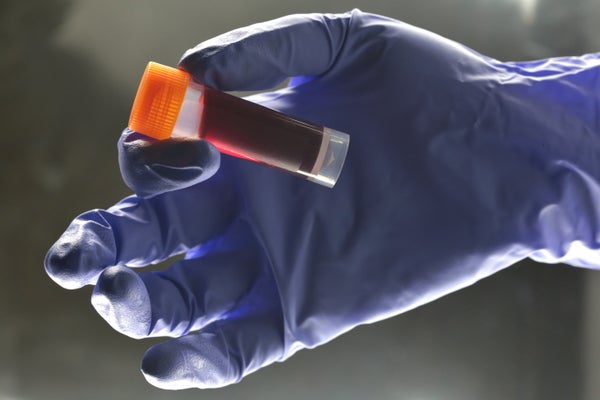A research group at the medical-device and health care giant Abbott has discovered a new strain of human immunodeficiency virus, or HIV—the first to be identified in 19 years. Abbott continues to look for potential new HIV strains to ensure that diagnostic tests for blood screening and detecting infectious diseases remain up to date, says Mary Rodgers, senior author of the paper announcing the finding and head of the company’s Global Viral Surveillance Program.
The new strain, called HIV-1 group M subtype L, is extremely rare and can be detected by Abbott’s current screening system, Rodgers says. The company’stestsscreen more than 60 percent of the global blood supply, she adds, noting it must detect every strain and “has to be right every time.”
In the early days of HIV/AIDS in the 1980s and 1990s, some blood donors unaware that they had HIV added the virus to the blood supply. A large number of patients who needed regular blood transfusions—among them, many with hemophilia—ended up contracting HIV and often dying. The supply has been essentially clear of HIV for years, and Rodgers says efforts such as Abbott’s will help keep it that way.
On supporting science journalism
If you're enjoying this article, consider supporting our award-winning journalism by subscribing. By purchasing a subscription you are helping to ensure the future of impactful stories about the discoveries and ideas shaping our world today.
The study, published today in the Journal of Acquired Immune Deficiency Syndromes, serves as a reminder of the dangerous diversity of the HIV virus, says Jonah Sacha, a professor at the Vaccine and Gene Therapy Institute at Oregon Health & Science University, who was not involved in the new research.
“This tells us that the HIV epidemic is still ongoing and still evolving,” he says. “The calling card of HIV is its diversity. That’s what’s defeated all of our attempts to create a vaccine.” More than 37 million people live with HIV worldwide—the most ever recorded. “People think it’s not a problem anymore, and we’ve got it under control. But, really, we don’t,” Sacha says.
Antiretroviral drugs inhibit the virus’s reproduction and spread, but they have significant side effects, he says. Even when drugs keep HIV under control, patients are at higher risk for blood cancer, cardiovascular complications and other problems.
The danger from the virus persists. A radically new viral strain could evade detection in the blood supply, avoid being controlled by drugs and render future vaccines ineffective, Sacha says. “Viruses break through all the time, and we’re not ready to deal with them,” he adds, “just like what happened with the original HIV.”
But Michael Worobey, head of the department of ecology and evolutionary biology at the University of Arizona, who was also not involved in the recent study, is more sanguine. Worobey says it is not a surprise that there are a diverse number of HIV strains in Central Africa, which is where the disease originated. Identifying a new one does not add much to the knowledge of HIV, he says.
“It’s actually misleading to describe genetic diversity from the [Democratic Republic of the] Congo as a new subtype,” Worobey says, “because the only useful meaning of the term ‘subtype’” would come from identification of a lineage of the virus that has spread significantly beyond Central Africa. Guidelines for classifying new strains of HIV were established in 2000. The recently discovered subtype belongs to the most common form of HIV, group M, which accounts for more than 90 percent of all HIV cases, Rodgers says.
Abbott created its surveillance program 25 years ago to track changes in HIV and hepatitis viruses. “We really need to be monitoring themto stay one step ahead of the virus,” Rodgers says. The program now includes 78,000 samples from 45 countries. No other new subtypes have been characterized since 2000, she adds.
The most recent of the three samples used to identify HIV-1 group M subtype L has been sitting in an Abbott freezer since 2001. The amount of virusin the sample was too low to read back then, but new technology recently made it possible. Comparing that sequence with the others made available by the research community, Abbott researchers found two additional examples of the strain—in samples from 1983 and 1990, also from the Democratic Republic of the Congo, hinting that it has been around for a while. “Now that we know it exists, it’ll change how we look for it,” Rodgers says.
The company’s tests focus on the part of the viral genome that does not change very much from generation to generation, which is why it was able to detect the new strain. The finding also suggests there are more strains to be found, Rodgers says. “The full diversity has not been characterized. We’re going to continue to look.”
